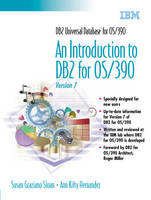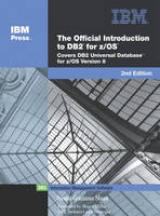
DB2 Universal Database for OS/390
IBM Press (Verlag)
978-0-13-019848-8 (ISBN)
- Titel erscheint in neuer Auflage
- Artikel merken
Spurred by IBM's success with DB2, thousands of new users are working with DB2 on OS/390 mainframes for the first time. Now, direct from IBM, there's an authoritative introductory guide to running DB2 in OS/390 environments. This book offers a practical, hands-on overview of everything new users need to know, from relational database and SQL fundamentals to basic design, administration, and application development. Now, new DB2 for OS/390 users have a single source for detailed introductions to every aspect of working with IBM's flagship database on mainframe platforms. The book reviews basic relational database concepts, SQL, the fundamentals of database design, the key tasks associated with day-to-day database administration in mainframe environments, application development, and more. Next, it introduces new users to a wide range of DB2's most sophisticated capabilities, including data sharing, distributed data, and Web access. For readers ready to go beyond the fundamentals, it also includes extensive cross-references to other IBM books and information resources.
For all developers, administrators, managers, and end users new to DB2 for OS/390 -- including those familiar with DB2 or other databases on other platforms, as well as those new to enterprise databases.
Susan Sloan is a programmer and database administrator at IBM's Santa Teresa Laboratory in San Jose, CA, where DB2 for OS/390 was developed; Ann Kilty Hernandez is a technical writer there. They both have extensive experience working with DB2 in communications and marketing roles.
I. OVERVIEW.
1. An overview of DB2.
Scenarios for using DB2. The IBM data management strategy. The DB2 Universal Database family. Open standards. For more information.
2. DB2 concepts.
Structured query language. DB2 data structures. Enforcing business rules. DB2 system structures.
Application processes and transactions.
Packages and application plans. Distributed data.
3. DB2 for OS/390 architecture.
OS/390 overview. DB2 in the OS/390 environment. DB2's lock manager. DB2 and the SecureWay Security Server for OS/390. DB2's attachment facilities. Distributed data facility. The Parallel Sysplex environment. For more information.
II. WORKING WITH YOUR DATA.
4. Designing objects and relationships.
Logical database design. Physical database design. For more information.
5. SQL: The language of DB2.
Executing SQL. Writing SQL queries to answer questions: the basics.
Putting the rows in order: ORDER BY.
For more information.
6. Writing an application program.
Using integrated development environments. What programming languages and methods can you use? Preparing an application program to run. Static SQL applications. Dynamic SQL applications. Using Java to execute static and dynamic SQL. Using ODBC to execute dynamic SQL. Using an application program as a stored procedure. For more information.
7. Implementing your database design.
Defining your tables.
Defining columns and rows in a table. Defining a table space. Defining databases. Defining your views. Defining indexes. Defining relationships with referential constraints. Defining large objects. Defining other business rules. For more information.
8. Managing DB2 performance.
Understanding performance issues.
Know the performance requirements.
Moving data efficiently through the system. Improving performance for multiple users: Locking and concurrency. Improving query performance. Other performance considerations. For more information.
9. Managing DB2 operations.
Tools for managing DB2. Issuing commands and running utilities. Managing data sets. Authorizing users to access data. Backup and recovery.
Database changes and data consistency.
For more information.
III. SPECIALIZED TOPICS.
10. DB2 and the Web.
Architectural characteristics of Web applications. Server-side programming on the Web. Application servers on the Web. Web products and tools. Using XML. For more information.
11. Accessing distributed data.
Introduction to accessing distributed data. Programming techniques for accessing remote servers. Coordinating updates. Minimizing network messages. For more information.
12. Data sharing with your DB2 data.
Advantages of DB2 data sharing.
Improves availability of data.
How data sharing works. Some data sharing considerations. For more information.
IV. APPENDIXES.
Appendix A. Example tables in this book.
Employee table. Department table. Project table. Employee-to-project activity table. Products table. Parts table.
Appendix B. Notices.
Trademarks.
Appendix C. Glossary.
Appendix D. Bibliography.
Index.
| Erscheint lt. Verlag | 29.11.2000 |
|---|---|
| Verlagsort | Armonk |
| Sprache | englisch |
| Maße | 178 x 235 mm |
| Gewicht | 920 g |
| Themenwelt | Informatik ► Datenbanken ► DB2 |
| ISBN-10 | 0-13-019848-X / 013019848X |
| ISBN-13 | 978-0-13-019848-8 / 9780130198488 |
| Zustand | Neuware |
| Informationen gemäß Produktsicherheitsverordnung (GPSR) | |
| Haben Sie eine Frage zum Produkt? |
